

Welcome to part six of my Coverage of Dungeons & Dragons’ 5th Edition Monster Manual! We’re doing half of the title of this game, Dragons! While not as much as the Demons and Devils, I do think that the Dragons are another type of monster that would benefit severely from a proper introduction page or two, something that the 5.5E/2024 Monster Manual did away with.
____________________________________________________
So being one half of the game’s title, you can believe that Dragons play a significant part of the game’s lore. In fact, any given bestiary tends to have a whole ton of brand-new dragon and dragon variants, in a volume that led to a frankly ridiculous degree in older editions. On top of my head, we’ve got Dragonborn, Drakes, Faerie Dragons, Dracotaurs, Dragonnes, Pseudodragons, Dragon Turtles, Dragonspawn, Dragonkin… and that’s not even getting into the “True” dragons! Gem Dragons, Ferrous Dragons, Catastrophe Dragons, Planar Dragons, undead variations of dragons…


It is important to note, though, that in all basic D&D, the primary movers and shakers of the world are the Chromatic and Metallic Dragons. There is a bit of a simplified handwave here, but the Chromatic Dragons lean towards evil and worship their five-headed goddess Tiamat, while the Metallic Dragons lean towards good, and worship the Platinum Dragon Bahamut. This has led the Chromatics and Metallics to clash against each other over the series’ history, although the specifics of different conflicts and how hostile a given individual dragon would be, of course, depends on the campaign. The fact that they are all intelligent and ancient means that some worlds and settings have vast networks of dragon politics connected to them.
While there will be many, many other variants over the many different editions, at its core, there are five main Chromatic Dragons (in order from least to most powerful: White, Black, Green, Blue, Red) and five main Metallic Dragons (also in order: Brass, Copper, Bronze, Silver, Gold). Again, the Chromatics represent the alignment of evil, the Metallics represent good, and the Gem Dragons, not in the base Monster Manual, represent the neutral alignment.
In a decision that some people have questioned, all Dragons have four stat blocks associated to them, based on their age – Wyrmlings, Young, Adult and Ancient. This allows parties of different levels to always be able to encounter a Dragon, with the youngest being ‘Medium’ sized, the size of an average humanoids, and the sizes going bigger and bigger until you get into the size of a dinosaur to something much larger. It does bring to mind the moralities of slaughtering babies of an intelligent species… which the franchise has kind of glossed over and handwaved over the years, but I think the consensus is that in general, wyrmlings are born fully sentient.
But what is important to note is that all Dragons have four legs, wings, a reptilian body, and a specific breath weapon that they can unleash upon their opponents. They are all highly intelligent, though their ability to cast spells vary differently depending on the edition. In a way to somewhat standardize their abilities, most dragons tend to have a preferred habitat, the changes they make to warp that habitat, a specific breath weapon, and usually a specific hoard.
In addition, 5E’s Monster Manual also lists a couple of dragon-adjacent creatures near their huge dragon introduction, which I thought made sense to be included here.
[The article was originally written in October 2019, and was revised in September 2025]
Normally I separate the 5E/5.5E artwork on top, and all other editions below. But the dragons all get multiple artworks in the 5.5E Monster Manual. So I'll put all the 5.5E artworks above the dragon's name, even if it does get a bit clump-y; the 5E and 4E artworks below; and all subsequent editions in reverse chronological order in the body of the review.
____________________________________________________



Black Dragon
- 5.5E/5E: Medium/Large/Huge/Gargantuan Dragon; Chaotic Evil; CR 2/7//14/21
Going off the order from the original 5E Monster Manual, we are going to go through all five of the evil Chromatic Dragons, and starting off we’ve got the Black Dragons. Almost all of the dragon designs tend to follow the standard ‘Western Dragon’ template, which does admittedly make it a bit easier for me to gloss over that since with the exception of one, all of the dragons have the same body layout. Ever since 3E, the game’s art direction has been great at giving each dragon some distinctive heads. The Black Dragon has two bull-like (or devil-like) horns that point forwards, and they also tend to have far more skull-like faces. 5E notes that the skin around a Black Dragon’s head slowly deteriorates as they grow older due to their acid, which is a cool little detail.
Being the stars of the franchise, each dragon got two artwork variations in the 5.5E Manual, an adult version and an ancient version. I also really like that the art direction of 5.5E has been to make each variation look a bit more distinct, and they definitely play up the ‘skull head’ aspect of the Black Dragon, making it look positively ghoulish. Interestingly, 5.5E brings up an aspect of the Black Dragon in that they’re also somewhat associated with undead, listing undead cults as being the potential type of minions that would voluntarily serve a sufficiently powerful Black Dragon.
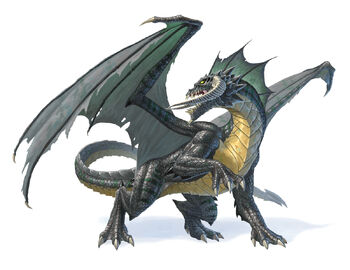

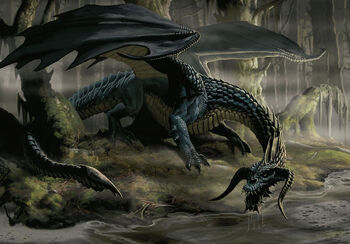
Each dragon, as noted in my intro, are going to also be special because of a couple of things. Firstly, their breath weapon. A Black Dragon breathes an acid breath, melting flesh and bones. Secondly, their habitat. Black Dragons lair in swampy areas, likely ones that are also filled with poison and ruins. It’s one of the perhaps more ‘traditional’ lairs for an evil dragon in folklore, and that’s what a lot of the chromatic dragons are – the types of dragons in the vein of your Smaugs and your Fafnirs, powerful ancient cruel beings that hide atop of mounds of treasure in remote places of the land.



Speaking of treasure, the Black Dragon’s flavour of treasure are the ‘wreckage and treasures of fallen peoples’… but since they’re cruel, sadistic bastards, a Black Dragons don’t need to wait before doing his little archaeology collection, and would manually make a fallen kingdom on his own. As in, toppling a kingdom just to have some fallen-empire treasure. Personality-wise, Black Dragons are noted to be sadistic and cruel, tormenting their captives and enemies just to see them suffer. Whereas other dragons live for conquest and greed, the Black Dragons just want to tear down everything around them and rule over what’s left.
All dragons, both chromatic and metallic, can cause the area around them to be warped by just creating a lair there. In the Ancient Black Dragon’s case, the 5E prose does note that this is caused by the constant dribbling of the acid from their mouth, and how they often leave their victims to ‘ferment’ in the swamp. I’ll probably not go through this for all the dragons, but for the Black Dragon, the water sources around its lair are supernaturally foul and cause those who drink it to vomit. Acrid fog, thick mud and gnarled plantlife make it hard to go through the swamp, and when they do fight against the Ancient Black Dragon? They are also able to cast spells. Older editions have most dragons be able to cast spells, but 5th Edition pares it down to just the ancient members of their species. In the Ancient Black Dragon’s case, depending on whether you’re working off 5E or 5.5E, it’s got anything from a cloud of insects, magical darkness, fear or swamp-water manipulation. ____________________________________________________



Blue Dragon
- 5.5E/5E: Medium/Large/Huge/Gargantuan Dragon; Lawful Evil; CR 3/9/16/23
Going to the second most powerful of the chromatic dragons, we’ve got the Blue Dragons, which represents a far more aggressive territorial aggression. Getting the unique identifiers out of the way, Blue Dragons breathe lightning bolts as their breath weapon, and their favoured habitat is in deserts or in other kinds of Badlands like steppes and rocky coasts. This habitat is especially important because Blue Dragons share their preferred habitat with Brass Dragons. Or rather, Blue Dragons don’t want to share their preferred habitat with Brass Dragons, leading to a bloody rivalry between the two.
From a visual standpoint, there has been a bit of a slight redesign, with 5E explicitly calling out that a blue dragon is “recognized by its dramatic frilled ears and the massive ridged horn atop its blunt head”. Come 5.5E, the distinctive horns are still there, but the ‘ears’ and ‘fins’ have been reduced to almost nothing. The artwork instead seems to want to highlight the horn and the row of smaller spikes on its dorsal side a bit more.
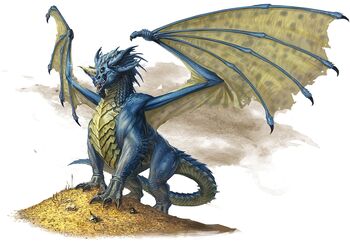

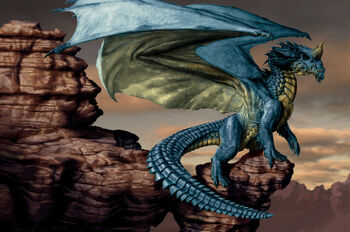
Interestingly, in addition to treasure of the normal kind (they like gems, especially blue gems!), Blue Dragons fancy themselves as tyrants and overlords. They want to dominate, something that the 5.5E manual really highlights – both 5E and 5.5E note that Blue Dragons often kidnap talented individuals, whether they’re artists or bards or sages; or powerful wizards and assassins, to press-gang them into its service. But 5.5E reveals that the end-game is for the Blue Dragon to create an empire of its own, a different kind of domination than the other four chromatic dragons. Of course, being dargons, this also means that the Blue Dragon leading an empire would either grow paranoid or be consumed in schemes against rivals; or once they reach Ancient age, get bored with running a kingdom and seek for more grandiose and over-the-top domination plans like conquering other realms, or forces of nature like time or life.
Whereas Black Dragons are cruel and delight in attacking weaker enemies first, Blue Dragons are noted to be far more patient and methodical. While probably not something that would translate well into a gameplay session, Blue Dragons are noted to love to turn combat into an extended affair of hours to days, doing an intense version of hit and run in that it flies in, launches an air strike of pure lightning, then flies back off to safety. In 5.5E, the ancient variant straight-up turn into stealth bombers, having access to the Invisibility spell. While this highlights the Blue Dragon’s airborne superiority, I do really like the description in the original 5E about how Blue Dragons will hide under sand to ambush caravans, with their nose-horn cartoonishly jutting out of the sand. Paints a bit of a different image compared to the harassing air-raids of its other combat tactic, no?



When Ancient Blue Dragons lair in a place, thunderstorms and sinkholes appear in areas all around them. Blue Dragons would even place some cheaper gemstones near some of the sinkholes it creates, specifically as a trap. And in addition to the typical army of minions that dragons usually have, Blue Dragons create specialized sandstorm-themed air elementals called ‘Dust Devils’. Somewhat like Beholders, they will also be happy to collapse the tunnels leading to its lair, which does help to showcase a bit of their intelligence and strategy.
____________________________________________________



Green Dragon
- 5.5E/5E: Medium/Large/Huge/Gargantuan Dragon; Lawful Evil; CR 2/8/15/22
Where the Black Dragons are sadistic psychos and the Blue Dragons are wannabe tyrants, the Green Dragons are consistently portrayed across the various editions as being the cunning, treacherous ones of the group. They are still as violent and powerful physically, but both 5E and 5.5E describe how they really like to use misdirection, trickery and magic to corrupt the good-hearted and innocent. 5.5E gives a really nice writeup describing Green Dragons as being a mystic, overwhelming ‘voice in the forest’ or the ‘whisper in their dreams’ that can cause easily-duped people to fear, worship and serve it.
Which, of course, brings us to the Green Dragon’s habitat. Of course the Green Dragon lairs in thick, deep forests! Their breath weapon is a cone of poisonous gas. I really think the 5.5E artwork shows us two amazing pieces of art, with the Adult Green Dragon swimming through a forest river and stalking its prey, while the Ancient Green Dragon is acting out one of her manipulations with magical puppets on the ruins of some temple. Those artworks really do a great job at making the Green Dragon extremely memorable, because visually they don’t exactly have signifiers beyond their colour. I suppose the somewhat more serpentine neck, the slight protrusions on the tips of its jaws and the spinosaur-esque dorsal fins, but they are all a bit too subtle if we’re being honest… and with ten variations on the dragon body shape in the base Manual alone, it’s not particularly memorable.
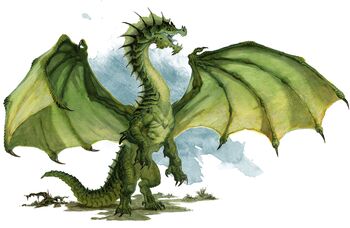
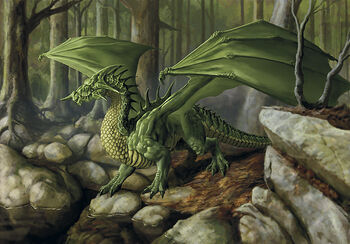
But it’s their behaviour where they shine. As noted before, the Green Dragon’s flavour of dominance and conquest is far more personal, loving to manipulate, double-talk and make promises with anything sentient. They value intelligence, and even if they’re not trying to ally themselves with a given group of sentient beings, they’ll take time to find all they can to see if a wandering group of adventurers will lead the Green Dragon to a new town, for example. When faced with inter-draconic conflict, Green Dragons often pretend to make itself look weaker and subjugate itself to the other party… only to wait for a chance for the other dragon to let down its guard and slaughter them.
Just like Blue Dragons, a Green Dragon’s favoured treasure are people. But it’s not the quantity, but rather the quality – popular heroes, renowned bards, well-known saints… I get the feeling that the Green Dragon is one of those who ‘enjoy the hunt’ kind of collectors. Perhaps seeing the overlap, 5.5E expands this a bit more to Green Dragons collecting items of extortion – not just compromising documents, but things like precious family heirlooms (or just family members) that powerful people will be desperate to get back. Again, they don’t want to be the heads of empires like a Blue Dragon. They want to be the ones pulling the strings of massive spymaster organizations that can cause all empires to dance.



An Ancient Green Dragon will warp the forests around them. 5E makes a big point of telling us how the Green Dragon can weave through the forest with its slender body, but once they’ve reached Ancient level they just become impossible to trace as they can manipulate the plants around them. Which I feel is a nice nod to the generally elusive nature of a dragon who wants to hide and do its manipulation in peace. Thickets create labyrinths around the Ancient Dragon’s lair, but my favourite has to be the fact that small creatures like rats and birds are supernaturally linked to Green Dragons, allowing the dragon to spy on you and learn your secrets, thus knowing how best to tempt you.
____________________________________________________



Red Dragon
- 5.5E/5E: Medium/Large/Huge/Gargantuan Dragon; Chaotic Evil; CR 4/10/17/24
As you probably can tell, I do like the Green and Blue Dragons the most among the otherwise somewhat-samey chromatics. But let’s now give some respect to the apex of the chromatic dragons – the central head of Tiamat and the guy on the cover of the very first Monster Manual, the most powerful of the chromatic dragons… the Red Dragon.
The thing about the Red Dragon is that… as the ‘ur’ example of the Chromatic Dragons, it’s basically all of the traits common to the other four Chromatic Dragons but ramped up to eleven. All of the most stereotypical ‘evil fantasy dragons’ apply here. The Red Dragon’s breath weapon? Fire, of course. Burning, burning fire. Their lair? Mountains and caves, just like good old Smaug from Lord of the Rings. Their preferred treasure? Giant piles of gold that they can sleep on. Their visuals? Horns and fins, a classic dragon head. Their personality? Utterly arrogant, unashamedly greedy, easy to anger, and ready to utilize their vastly superior might to intimidate or otherwise destroy anything before them.
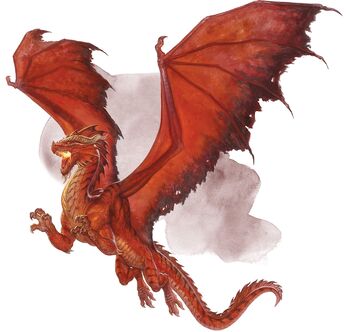

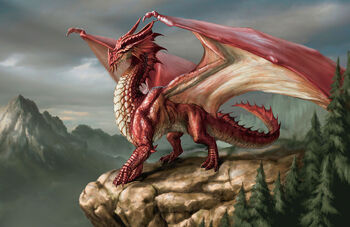
It’s very simple, very easy to understand… and while I respect the need to have a ‘classic’ example, it also means that there’s probably the least to say about the Red Dragon that I wouldn’t have already said when explaining the chromatic dragonkind. The original 5E even notes that the Red Dragons are ‘regarded as the archetypal evil dragon by many cultures’.
And indeed, the Red Dragon seems to have traits of the Black, Blue, Green and White, but a bit more… diluted. They’re intelligent enough to want to manipulate everything and have minions and spies, but not as much as the Green; it’s a tyrant, but it’s nowhere as methodical as the Blue. They’re cruel, but not sadistic to the degree of the Black; and while they fly into instinctual rages, they’re not purely driven by instinct like the White. One thing that I did like about the Red Dragons is something drawn from Smaug as well, where Red Dragons are so greedy and in-tune with their hoard that they can judge the value of a treasure right down to the copper piece, and they can tell if even a single coin has been stolen from their hoard.



And it might seem that I’m a bit dismissive of the Red Dragon, but that’s mostly because the other four chromatics do quite a good job at carving their own little niches in the trope of ‘evil, greedy, conquering dragon’. The Red just does all of it… but with some of the most basic tropes. Volcanic lair with crags and earthquakes all around it, fire breath, fire spells, the whole works. They believe themselves to be the greatest of all dragons, nay, all creatures. It’s a simple mindset, one that works well as a simple antagonist, and even the big bad in a campaign of multiple dragons.
____________________________________________________



White Dragon
- 5.5E/5E: Medium/Large/Huge/Gargantuan Dragon; Chaotic Evil; CR 2/6/13/20
An interesting thing about dragons in fantasy media is that there are different tropes people expect from dragons. The other four chromatics fulfill the ‘evil scheming antagonist, but a winged magic lizard’ trope, but there’s also something to be said about merely using dragons as essentially souped-up giant kaiju monsters that don’t care about negotiating with you, they’re just forces of nature that want to chomp on you. And that’s where the White Dragons come in.
They are noted to be the runt of the litter among the five chromatic dragons, and the most ‘animalistic’. They’re still sentient, but they are mostly just vicious and driven by hunger and the thrill of the hunt. They don’t care much for cunning and tactics, just to hunt, survive, and slaughter en masse. Survival is what they care for, and this has led to a life of a dragon that is always hostile and territorial to anything that comes into its territory. The 5E artwork does a great job at showcasing the posture of the White Dragon as being more hunched-over, more bestial, and lacking the quasi-humanoid stance that the other chromatic dragons have. Distinguished by a backwards-pointing head crest, I do really like how the 5E artwork makes the White Dragon look more like a rabid dinosaur or lizard, and 5.5E doubles down in making its White Dragon look a lot bulkier and a lot more feral.
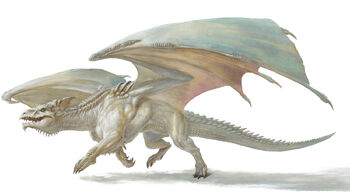
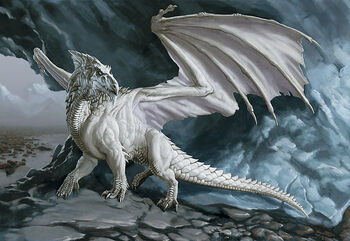
The White Dragon’s habitat is in the icy wastes and tundras, and naturally their breath weapon is a blast of ice. This is apparently essential to the White Dragon’s feeding habits, for they will only devour creatures that has been previously frozen. In a way, this also translates into its treasure hoard, because it encases its kills in ice and buries them like a twisted natural refrigerator, and powerful enemies become trophies in its lair. What normal gold and gemstones are also sealed within ice, which adds to an extra layer of protection that prevents adventurers from easily accessing it.
White Dragons are also isolationists, barely interacting with even their own kind, making it somewhat unique among the chromatics in that White Dragons don’t exactly have a designated ‘minion’ pool. Thanks to shared habitats, they often come into conflict with Silver Dragons. They have an intensely extraordinary memory, able to recall every insult and will allow that desire for vengeance to last for decades. In a slightly more positive twist of attitude, this also allows the White Dragon to recall every victory associated with every piece of treasure.


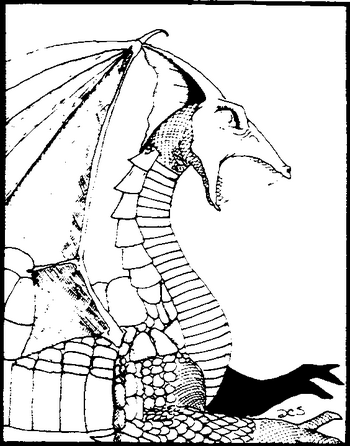
An Ancient White Dragon warps the area around them to create blizzards, glacial gloom and ice walls, but honestly, considering that it’s already the icy tundra those things are likely to be already there regardless of a dragon’s presence. What I do like is the little detail that the White Dragon can sense via the changing of the icy winds the presence of interlopers in its territory. That is perhaps a nice hint as to why the White Dragons are such effective hunters.
____________________________________________________
____________________________________________________



Brass Dragon
- 5.5E/5E: Medium/Large/Huge/Gargantuan Dragon; Chaotic Good; CR 1/6/13/20
And now we enter the Metallic Dragons! Perhaps a bit more esoteric to someone who doesn’t play a lot of fantasy settings, Metallic Dragons are the opposite force to the chromatics. Serving the lawful good Platinum Dragon God, the Metallic Dragonkin wish to preserve and protect, seeing their powerful might as a way to aid the smaller races instead of subjugating them. That said, a lot of their biology is very much similar to the chromatic dragons – age groups, breath weapons, preferred habitats, even hoards. They’re just a bit less likely to be adversaries… at least not in the normal way. Just with any well-intentioned good overlord, what they define as ‘good’ might run counter to what your party sees as important.
Going by alphabetical order, we start off with the weakest of the Metallic Dragons, the Brass Dragons… which by a vast margin is my favourite of the five Metallic Dragons. Let’s get some things out of the way first. Brass Dragons tend to lair in deserts and caves, putting them into conflict with the Blue Dragons. All Metallic Dragons have two breath weapons, which sounds unfair, honestly! Brass Dragons can unleash flame, but also a sleep gas. Adult and Ancient versions of all Metallic Dragons can also shapeshift into humans, which is expanded to a full spellcasting list in 5.5E.
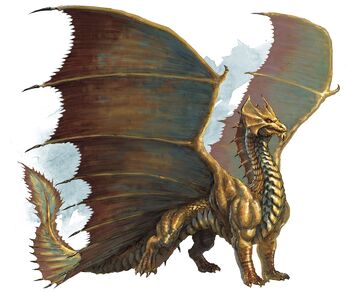
That shapeshifting-into-humans is something that Metallics can do, presumably because the Chromatics are too proud to take on the forms of ‘lesser’ humanoids? This shapeshifting ability allows the Metallic Dragons to act as seemingly innocuous NPCs in cities until it’s revealed that, they’re actually a shapeshifted dragon… but in older editions, this also explained the, um, origins of a lot of part-dragon children.
Anyway, Brass Dragons! Brass Dragons are fun because… that’s their whole personality! They are gregarious, they love conversation, and they absolutely want to talk to you. As in, they really, really want to talk. Any creature that tries to leave the Brass Dragon without talking will cause it to follow that creature, and if they are so rude as to not even converse, the Brass Dragon will use its sleep gas breath to knock out the creature, at which point they will find themselves buried in sand up to the neck until the Brass Dragon has that conversation.
That’s utterly hilarious and a bit unexpected from such an imposing figure! But considering the rest of the dragons are a lot more po-faced, I do appreciate that at least one of them exhibits a rather odd vibe that highlights the strange priorities of these immortal beings. 5.5E tries to give a more practical and serious tint to this obsession with conversation by portraying Young Brass Dragons as serving as couriers for older Metallic Dragons, while the Ancient Brass Dragons create world-spanning networks to combat misinformation and repression, which I suppose is a nice little expansion as the town’s local gossipmonger.



Brass Dragons also hoard treasure, preferring items with a fun story attached to them. 5E gives them a hilarious desire for magical objects… but specifically talking magical objects. They want to converse with them! 5.5E makes the Brass Dragon a bit more dynamic as well, noting that they like to lair near oases and crossroads, appearing in their human forms to try and soak up as much talks with interesting people. This translates to an Ancient Brass Dragon’s regional effects, which instead of warping the land, tends to revolve around springs of refreshing water appearing more often around the lair, magical tracks that lead people to shelter in sandstorms… and when the Brass Dragon wants to ward off interlopers, desert mirages and illusions.
Physically, the Brass Dragon has a distinctive set of axe-shaped head crests, but the most striking feature has to be their wings. Brass Dragons have a pair of kite-like wings that extend all the way down to the tail, which looks a bit odd but does admittedly help to give them a very distinct look. Originally sharing this body plan with some other Metallics, 5.5E made this kite-body wholly unique to the Brass, even showcasing an Ancient variant with a much more flowery, leafy shape.
____________________________________________________



Bronze Dragon
- 5.5E/5E: Medium/Large/Huge/Gargantuan Dragon; Lawful Good; CR 2/8/15/22
I will be the first to admit that I don’t really know about the colour of precious metals, so I can’t really comment on which colour is more accurate for the Bronze Dragon. 5E gives us yellow scales with green highlights around the wings (which happens sometimes on bronze, I know that much), while 5.5E goes for a reddish-brown look. I feel like bronze is one of those metals that can change its tint depending on conditions, but the artwork for 2E through 5E have all consistently used the ‘dark yellow with highlights’ vibe, and it’s a bit harder for me to see the 5.5E design and not be confused with the Copper.
The Bronze Dragon are noted to be one of the more aquatic dragons, living in coastal regions. This led the 5E design to give them prominent fins on their dorsal side, and even their head-horns kind of resemble fins. 5.5E goes full-on in making the Bronze Dragons a lot more semiaquatic looking, in addition to the colour change. They’ve got webbed feet which was mentioned in 5E but not shown in the art. They’ve gained more fins on their legs and belly, their head-crests remind me of a lionfish, and their wings seem to have been modified to resemble paddles. But most dramatic are their tails, which are much larger with massive fins on both ends, giving the look of an oarfish or sea serpent. This culminates in the extremely awesome art of the Adult Bronze Dragon fighting against a giant shark underwater!
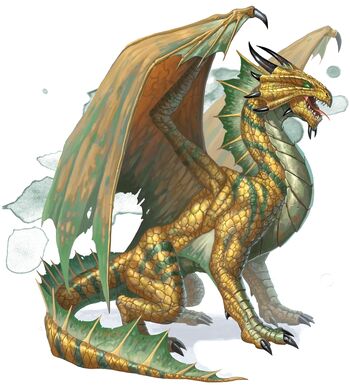

So visually, the Bronze Dragon has been catapulted into being very memorable in my head. Personality wise, though? They are the most battle-hungry of the Metallics, but in a good way. They want to test their mettle against evil forces, and even if battle erupts near it, Bronze Dragons will wait until they have ascertained which side is just before joining the fight. It’s… not the most interesting, if we’re being honest, and in my original review I highlighted the Bronze Dragon as the ‘ur’ example the way the Red was for the Chromatics.
5.5E actually picks up on a different aspect of the Bronze Dragon’s previous publications, highlighting their role as really liking the wonders of the world. Bronze Dragons are reframed to strive to preserve innovations, technology and invention. They are gung-ho problem-solvers who want to try and fix the world, which marries quite well with their original 5E lore! They want to share and mentor the younger races, and their hoard (which wasn’t even mentioned in 5E) are items that could be useful one day. Their lairs also now make a bit more sense, with the coastal locations being the places of natural beauty they want to preserve, while the sunken ships are also locations where some of these knowledge might have been lost.



In combat, Bronze Dragons have a lightning breath (similar to their territory rivals, the Blue Dragons) and a force breath. Yes, yes, it’s Fus Ro Dah. They can also shapeshift, often preferring to turn into aquatic animals to spy around the people around its territory. An Ancient Bronze Dragon’s regional effects are a fair bit more cosmetic, being a simple ‘control weather’ effect, more buoyant currents for ships, and the ability to create illusions like music and echoes in its lair.
Overall, I do think the little hooks in making the Bronze Dragons into zealous problem-solvers is something that makes them way more interesting as a plot hook. Both as an interesting character – with the description of a wyrmling being a bit too over his head in trying to solve problems – but also as a potential antagonist, because what happens if a Bronze Dragon views a particularly dangerous magical innovation as something to be shared with the world, or if their idea of help accidentally causes more harm than good? Those are nice ways to make Metallic Dragons into antagonists while still keeping their nominally-good alignments.
____________________________________________________



Copper Dragon
- 5.5E/5E: Medium/Large/Huge/Gargantuan Dragon; Chaotic Good; CR 1/7/14/21
Joining the Bronze Dragon as the Metallics’ wackier representatives are the Copper Dragons. Where the Bronze Dragons are talkative gossipers, Copper Dragons are utterly mischievous little pranksters. They enjoy jokes, pranks and generally are jovial and fun guys to be around. Their original 5E design is probably one of the most ‘generic dragon’ designs in the book, with only the beautiful copper shading and the greenish tint in the wings setting it apart. 5.5E gave a distinctive new look, turning the Copper Dragon’s neck into a very serpentine one, and giving the Copper Dragon a massive smile. Its colours are also altered a bit to have the greenish copper shades run down its body like little neon lights, which isn’t a design choice I like as much as the original… but the snake neck and the wide smile, I do appreciate.
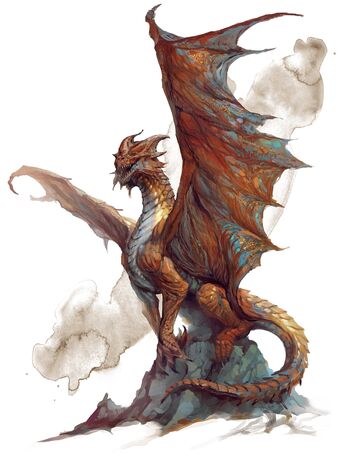
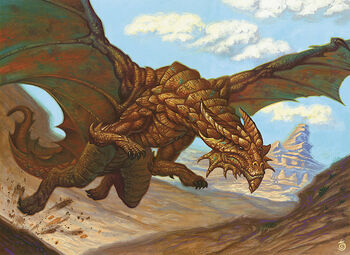
Again, the Copper Dragon is a combination of two very strong and honestly very human-like emotions. In addition to its loud attitude towards witty jokes and riddles, they also get irritated very quickly at people who doesn’t appreciate humour, and are especially ‘miserly’ and paranoid about protecting things in its hoard. This leads to them designing their lairs to show off worthless items, while all of the fancy artwork and oddities (and you believe a prankster like this would have a lot of weird stuff in their collection) are in hidden chambers. Their brand of treasure are things that are given with a certain ‘meaning’, and that is a nice, cute extension of their desire for connections with mortals. 5.5E also extends the Copper Dragon’s love for pranks and jokes into something a bit more practical, characterizing older Copper Dragons as the ultimate networkers, introducing one group of friend to another if she thinks they can benefit from each other.
A Copper Dragon’s two breath weapons are acid and slowing gas… which honestly? Acid is probably the ‘funniest’, DC-Joker-style breath weapon you could steal from the chromatic dragons. The 5.5E Manual does note that the Copper Dragon really hates using their violent acid breath, preferring to subdue their opponents through alternate means. I’ve been skipping about the dragons’ legendary actions and spellcasting abilities, but the Copper Dragon gets ‘Giggling Magic’, essentially forcing someone to be immobilized by fits of laughter while taking psychic damage.



Copper Dragons lair in hilltops and I absolutely love their regional effect. Intelligent creatures within a mile of the dragon are prone to fits of giggling. Magical carvings of the dragon’s smiling face are seen all over the terrain. Tiny beasts gain the ability to speak… but only to extol what a handsome and wondrous and cool dragon the Ancient Copper Dragon is. None of these actually debilitate anyone’s journey to the Copper Dragon’s lair, they’re just there to be funny.
I just really love the Copper Dragon, really. I love all of the awesome art that all the 5.5E dragons have received, and I’m not downplaying any of those… but I really do think that the 5.5E art for the Ancient Copper Dragon is such a nice one, showing the great dragon babysitting close to a dozen baby wyrmlings, including chromatic ones! And there’s even puppies and kitties there!
____________________________________________________



Gold Dragon
- 5.5E/5E: Medium/Large/Huge/Gargantuan Dragon; Lawful Good; CR 3/10/17/24
The Gold Dragons are the Metallics’ answer to the Chromatics’ Red Dragons. The most powerful of the bunch, the most majestic and regal, and the one that embodies the Metallic Dragons’ status as paragons of justice opposed to the forces of evil. I will start by saying that the Gold Dragons have received the biggest visual overhaul between 5E and 5.5E, and interestingly, they went all the way back to basics.
The 5E Gold Dragon has the same ‘kite-wing’ body that the Brass Dragon has, albeit a bit more jagged, with a lot of tendril-like beards and obviously bring all gold. It’s a good design, a distinctive one, but for all the gravitas that the prose talks about the Gold Dragon, there’s a certain je ne sais quoi that’s lacking. 5.5E revamps the Gold Dragon and the artwork for the Adult and Ancient Gold Dragons look nothing short of breathtaking. Majestic, coiling serpents with elaborate heads that has white as a very nice complimentary secondary colour; massive sail-like wings from a four-legged body, and a long, tapering tail that curls around the scenery. Instead of weird barbed tentacles, the new Gold Dragon has proper whiskers, which trail backwards with the rest of the head crests. The 5.5E Gold Dragon combines the Eastern and Western dragon designs, and with the trope of dragons being forces of good as something that originates from Eastern myths, it is quite appropriate that the most powerful of the metallic dragons has this look. It’s not even something that the art team pulled out of nowhere, since the first two editions’ artwork of the Gold Dragon is already based on the Chinese Dragons. It a very much welcome return, and one that helps to declutter the very-samey batch of dragons.
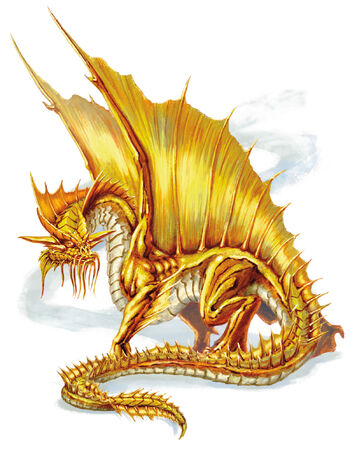

It really is a much-welcome change, since the Gold Dragon already felt like they’re trying to homage tropes common to the Eastern Dragon (the whiskers, the ‘rippling motion’ it makes as it flies, its role as a protector) but while also trying to visually make it similar to the others. This is a very much welcome update, and the art department really knocked it out of the park.
A Gold Dragon’s breath attacks are fire (making it one of the two Metallic Dragons to breathe fire) and a ‘Weakening Breath’ that saps the strength of those it hits. In combat, in addition to the usual litany of draconic tricks, Gold Dragons are also able to briefly see into the future and dodge attacks, or to cast the ‘Banish’ spell – into a dream plane that the Gold Dragon has imagined into being.
The Gold Dragons do not have a properly specific habitat, preferring out-of-place locations that allow them to live in solitude, such as idyllic lakes, caves behind waterfalls, and mist-shrouded islands. The regional effects caused by the dragon are mostly benign, like mists that ward off evil pursuers, or the ability for the Gold Dragon to converse with people in their dreams. Again, all tropes that are already associated with East-Asian mythology, which is yet another reason why I am quite happy to see them properly embracing the inspiration.

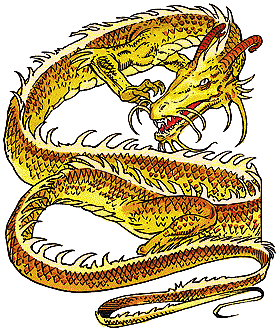
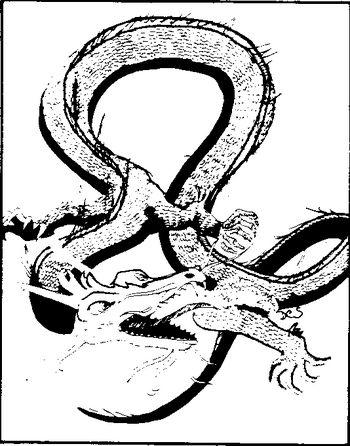
Older Gold Dragons are noted to be the most aloof and grim, being extremely focused on their work and keeping fraternizing to what is necessity. When they do communicate with the world at large, they make liberal use of their shapeshifting guises. They do hoard treasure, but they are likely to utilize their riches and ‘invest’ them in the greater good – buying rare books, pay informants, and sponsor idealistic adventurers. Only when stakes are truly high do these most Ancient Gold Dragons reveal themselves and join the fight.
Anyway, Gold Dragons are a neat way to bring some nice colour into any fantasy world. Again, these powerful Metallic Dragons tend to get less of a shine in conversations about monsters since they’re likely to be NPCs, but thinking of a way to cause your players’ goals to come into conflict with the good-aligned dragons definitely sounds like a nice setup for a moral quandary, isn’t it?
____________________________________________________



Silver Dragon
- 5.5E/5E: Medium/Large/Huge/Gargantuan Dragon; Lawful Good; CR 2/9/16/23
Last among the Metallic Dragons are the Silver Dragons, who, appearance-wise, also look pretty ‘basic’ as far as dragons go, only distinguished by a rather impressive spinal fin-crest. The Silver Dragon’s whole deal is that they are dragons of virtue, and are the most traditionally heroic of dragons, wanting to do good deeds and ensuring that harm doesn’t come to others around it. They’re also super-friendly, although they don’t quite have the same quirks that their more interesting cousins, the Brass and Copper Dragons, do. They’re more likely to make friends with the humanoid races by living amongst them as a human, and this extends to them having a massive fascination for humanoid history – leading to its preferred hoard being aspects of humanoid culture; and its preferred lair being “lost outposts of human civilization”. Those that don’t manage to get this tend to go for snowy mountaintops or cloud palaces.
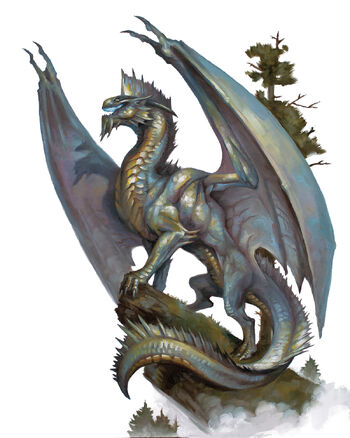
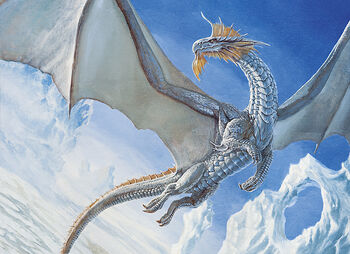
I… I really don’t find the original 5E Silver Dragon particularly that interesting thanks to this writeup, because there’s nothing inherently special about it compared to the other Metallics. The Brass and Copper engage in humanoid races in a far more memorable way; the Gold’s isolationism makes it a far more cooler ‘greater good’ mentor; and the Bronze actually being zealous problem-solvers takes over the niche of a more proactive problem-solvers. The Silver just feels like the Red Dragon in doing everything but nothing particularly interesting… except the Red Dragon gets to be the apex of the Chromatics.
Where 5.5E has been quite good at trying to look for a hook and go deep into it for most of its dragons, demons and devils, the Silver Dragons are just kind of… there, just being there as pillars of decency and sometimes living amongst human or humanoid society. Oh, right, breath weapons. Silver Dragons breathe cold and paralytic gases, and the regional effects of an Ancient Silver’s presence are rather generic weather-control.



It really is quite surprising – I know that the five chromatics and the five metallics can be quite ‘samey’, and a lot of the differences only really come up when you pull on the themes that the writers build them up to – but I really felt that over the five editions, the other ‘core’ dragons have gotten a fair chunk for any world-builder to place them in their world, Silvers feel like it’s the most bland and redundant of the Metallic Dragons. I really wished they had emphasized perhaps the Silver Dragon’s infiltration of humanoid society a bit more, or something along those lines, but as it is, while I discovered (or rediscovered) a lot of fun little titbits about the other nine main draconic families, I feel rather underwhelmed with the Silver.
____________________________________________________
____________________________________________________

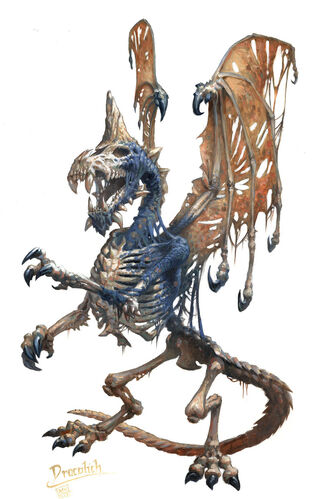
Dracolich
- 5.5E/5E: Huge Undead; Lawful Evil; CR 17
The base Monster Manuals give us a couple of draconic variations as well outside of the primary chromatic and metallic dragons, and since they fall here in the original Monster Manual's alphabetic order, I'll cover them in this page as well. Most iconic among these are the Dracolich, combining two of D&D’s most iconic enemies. Undeath is always a very common trope in fantasy settings, and the Dracolich is rather obviously an undead dragon. Dragons are already long-lived, but this means that some dragons seek a way to avoid their ultimate fate. In their greed and narcissism, they turn to darker powers and turn themselves into an undying Dracolich.
Dracoliches visually are just… well, dragon skeletons. It’s a simple but effective design – skeletons of large creatures are pretty cool in real life, so it’s not too far of a stretch to extend it to a large mythological beast like the dragon. Both 5E artworks show their respective Dracoliches (which correspond to their edition’s Blue Dragons) reduced to almost bone, but the tattered wings and some remaining skin and flesh are still around.
Unlike what a merely reanimated dragon skeleton would be (which would fall under the ‘Skeleton’ or ‘Bone Golem’ monster classifications), Dracoliches are fully sentient, with the mind of the original dragon still present. This transformation is frowned upon by most dragons, since the state of undeath cuts off a Dracolich from all dragon gods, even the nominally evil Tiamat. This is apparently one of the few things that Chromatic and Metallic Dragons can agree with, viewing the Dracoliches as a perversion of the dragons’ nature.


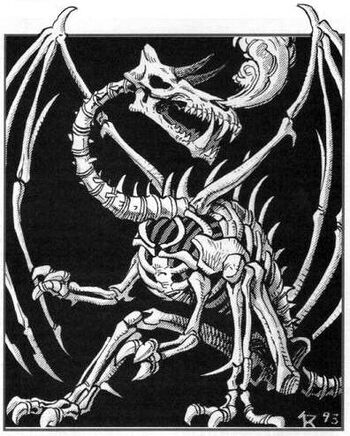
Just like regular liches, a Dracolich’s soul is bound to a artifact called a phylactery (renamed Soul Gem in 5.5E, but functionally identical). And this is what separates a lich from a lesser undead – if a Dracolich’s bones and physical form are shattered, the soul returns to the phylactery and the body just regenerates. 5E even describes that if the phylactery is embedded into a different dragon’s corpse, that body can serve as an instant new body.
The Dracolich is a ‘template’ that you could use to whatever true dragon type you want – which is interesting because the 5E Dracolich statblock keeps the ‘base’ Blue Dragon’s lightning breath, while the 5.5E version goes full undead and replaces it with a Necrotic Breath instead – depicted in the art as a roiling cloud of noxious purple smoke shaped like clumps of screaming tormented skulls.
Overall, I really like this one. It’s a combination of two really iconic monsters, and always guarantees some kind of backstory for the villain. I feel the best ‘boss’ D&D monsters are designed like this in the Monster Manual, a direction that I feel they’ve been pushing with some of the dragon entries as well – it’s not specific enough that your world-building could be stunted, but there’s a guaranteed story there.
____________________________________________________

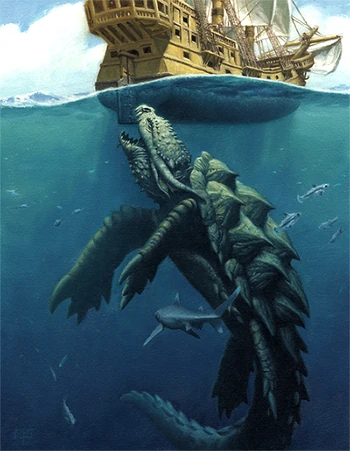
Dragon Turtle
- 5.5E/5E: Gargantuan Dragon; Neutral; CR 17
Yes, these guys are dragons, too. Dragon Turtles are gigantic island-sized turtles whose draconic mouth could chomp down on a galleon with ease. Different D&D editions have waffled back on forth on whether the Dragon Turtles count as dragons or not, because they look so different… although since 3E, they have been consistently listed as ‘Dragon’ in their classification, albeit with the odd note that they don’t fit into the chromatic/metallic classification. I do think that the trope of a gigantic, underwater kaiju-sized dragon is extremely valid, and this dragon just happens to take the form of a gigantic monster turtle! Many myths already feature ‘turtle islands’ anyway, so I’ve always been a fan of the Dragon Turtle.
One of my particular favourite official writings for the Dragon Turtle comes from the 5E dragon sourcebook, Fizban’s Treasury of Dragons, written by a disguised dragon god Bahamut. He breaks character when talking about Dragon Turtles, being absolutely confused as to where these guys came from – neither he nor the chromatic dragon god Tiamat created the Dragon Turtles, yet they exist, and they are dragons.
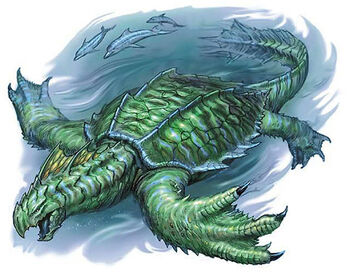


They may be much larger than their more land-locked kin, but the Dragon Turtles still have some aspects similar to dragon. Their breath weapon is a ‘steam breath’, which deals fire damage both in the water and outside of it. I thought that’s pretty cool! Their lair, obviously, is the deep abyss of the oceans, and their treasure are sunken ships. I love the 5E writeup about how Dragon Turtles are very happy to accept bribes and tributes for ships to pass through their territory. Personally, I really do like this – the idea of a giant island that happens to be a sentient titan really speaks to me.
While a bit of an anomaly compared to the regimented roles and appearances of the chromatic and metallic and gemstone, I find it refreshing that a couple of dragons just are a bit more interesting visually and conceptually.
___________________________________________________

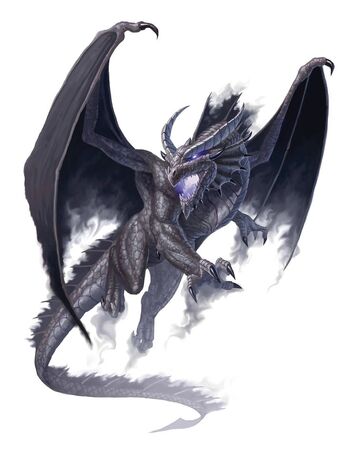
Shadow Dragon
- 5.5E/5E: Huge to Large Dragon; Chaotic Evil; CR 13
- 5.5E: Medium Dragon; Chaotic Evil; CR 4 (Juvenile Shadow Dragon)
Another dragon listed in here is the Shadow Dragon, which has gone through one of the bigger retcons in 5th Edition. Previously, Shadow Dragons were their own distinct breed of dragons that originate from the Plane of Shadow – or the Shadowfell, as it’s known since 4E. The fifth edition has instead made the Shadow Dragon into a ‘template’, which means you take your preferred original dragon, then attach some traits associated with Shadow Dragons to it. Any true dragon, chromatic or metallic or gem, that are either born in the Shadowfell or spent enough time there, gets corrupted by the Shadowfell’s creepy energies and are transformed into Shadow Dragons.
The Shadowfell’s energies are a mixture of death and negative emotions, and the dragons that are corrupted by it become either very happy vectors for these energies, or are driven mad by their corruption that not much sentience is left. I do like the little description in the 5E entry noting that portals to the Shadowfell often open up in dark, secluded locations… which includes the caves that dragons often lair in. Sometimes, slumbering ancient dragons get dragged in without even realizing, with the corruption happening while they slumber.


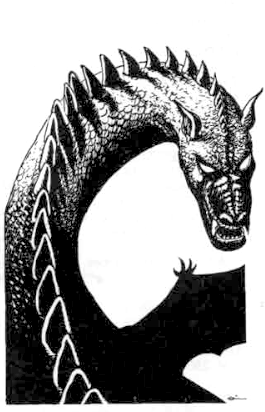
In combat terms, the Shadow Dragon gains a couple of new tricks, exchanging its breath weapon for a ‘Shadow Breath’ that deals necrotic damage, and any humanoid killed by the Shadow Breath gets transformed into an undead being called a Shadow (who we’ll cover later). They can also themselves hide in shadows, get partially incorporeal in the darkness, and slightly weakened by sunlight. Visually? They are just one of the main dragons with a shadowy filter over it, with shadows bleeding off their body. Both 5E and 5.5E use a ‘Shadow Red Dragon’ as their templates for the statblocks and the artwork.
Not the biggest fan of this one, if we’re being honest. It’s a nice little ‘boss’ for a Shadowfell-themed adventure, but I also think there’s a lot to draw from a plane of shadows, death and negative emotions other than just the lowest-hanging fruit of 'dragon, but shadowy'.
Some of these changes are really cool.
ReplyDeleteI like how the green dragon wyrmling shows how dangerous a small dragon can be with that poor sap lying on the ground
These visually changes to the metallic dragons are great, because I can finally tell bronze, brass, and copper apart.
Something I think is neat about Silver dragons is how they are the most likely ones a party will run into, since they are more public with appearances. No
There are some changes in the 2024 Manual that I don't necessarily agree with... but I think every single dragon entry is a huge banger in terms of making them distinctive both visually and lore wise.
DeleteReally love the artwork updates, too -- the Gold and Green Dragons in particular look amazing thanks to the surroundings around them.
Agree with the metallic changes too! Since the colours tend to blend together (other than Silver and Gold) due to the metals themselves having different shades based on oxidation, visually they are really difficult to tell apart. Now it's a lot clearer!